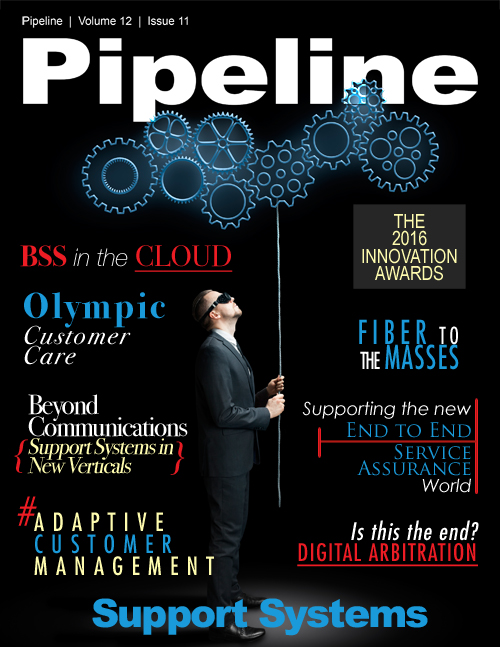Masses of Innovation
Business Support Systems: Cloud is also targeted in BSS innovations. Ericsson Revenue Manager is a cloud resident, “catalog-driven convergent real-time charging and billing system”…delivered with technologies such as Apache Cassandra and Hadoop.” It’s another agile entry for provisioning time-to-market in 2-5 days; so also is TRACT® by goTransverse. Transverse’s cloud-based product and service deployment solution is targeting newer state of the art service domains such as “cloud solutions, digital entertainment and media, Internet of Things (IoT), Machine-to-Machine (M2M), Over-the-Top (OTT) streaming services, connected car/telematics, logistics” providing monetization and subscription management. NEC/Netcracker’s Converged BSS solution, another Cloud-enabled platform, also targets “next-gen services, enables complex partnership models, creates customer-specific promotions, and support cross-industry offerings.” Netcracker’s message underscores the value achieved in a full integration across OSS and BSS.
Network Technology: ADVA Ensemble Connector expresses itself as a “Pure‐Play NFV Platform” meaning it is hardware agnostic and supports multiple VNF vendors. “Ensemble Connector handles virtual switching, flow steering [and security] across L2, L3 and MPLS physical and virtual network systems and Carrier Ethernet 2.0 functionality.” gen-E OpsCenter™ InfiniView is “a business intelligence platform providing automated mediation, advanced analytics and a real-time dashboard view into overall business health and performance.” A theme across several categories was using analytics as an engine to combine data from different lines of businesses, technologies, services, networks, systems and tools.
InfoVista’s Ipanema uses the controller/appliance SDN/NFV technology separation to orchestrate network functions, aka, VNFs. It leverages innovation inherent in autonomic functionality of “self-learning, self-adapting and self-healing application." It provides “application control, dynamic hybrid wide-area network (WAN), WAN optimization and WAN security in real-time for enterprise networks.” The ItsOn platform provides a service implementation as a service platform that could run in parallel to legacy operations to allow rapid introduction of new services.
Managed Services: Amdocs Value Mining Service uses the Amdocs’ ORBIT Business Intelligence platform. Amdoc’s professional services focus “on optimizing CSPs’ IT environment and maximizing its existing assets’ value by identifying and improving areas with the highest monetary business value per the company’s business goals.” CSG International Managed Services deploys its Business Support Systems (BSS) engine to the “provision of complex operations; proactively translates strategy into a vision for how BSS should evolve; and deconstructs current BSS infrastructure to create flexibility and agility.”
Customer Experience Management: Amdocs Contact Center Services transforms “the contact center into a growth engine…” by providing “a personalized, omni-channel, proactive experience for the end subscriber.” Apptium entered Cognitive Troubleshooting. Here innovative technology was apparent in its use of “predictive analytics, graph database and machine learning to improve customer experience by automating problem resolution,” proactively eliminating negative customer issues”. CSG Ascendon™ targets agile delivery of new services through its overlay design – “an integrated digital overlay to an organization’s existing systems” is implemented in the cloud. ItsOn the cloud. ItsOn’s platform is a full customer service application stack built from scratch for cloud implementation. InfoVista’s VistaNEO solution “automatically post-processes and aggregates call records into rich and accurate network and geo-located subscriber intelligence that can be converted into actionable insight about [a group of customer’s] quality of experience (QoE)”. NEC’s Netcracker Customer Experience Management (CEM) solution “leverages underlying analytics capabilities to gather information from a wide range of sources (structured and unstructured) and drive smarter business decisions based on the collected data.”
Big Data and Analytics: Some entries targeted the computation and then use of analytics to improve customer services. Here there was overlap with the products in Customer Experience Management. In these action-oriented products, crossing thresholds triggers work flows or other action-oriented responses. Ericsson Expert Analytics uses “untapped provider data” to compute its proprietary Service Level Index (SLI). The “SLI measures the perceived experience of individual subscribers based on real-time measurements and provides insights into how to improve satisfaction. The SLI predicts customer satisfaction and proactively eliminates the root-cause of the problem so it will not re-occur.” Procera Networks entered ScoreCard. This product provides a service console view that helps management understand and act on metrics of customer mobile experience. Subex’s Revenue Operations Center, ROC, combines technology and domain expertise to deliver meaningful business insights by applying patterns in big data to “generate nuggets of information – which are Consumable, Actionable and Contextual”.
Flytxt and the NEON platform interwork actionable insights reflecting mobile consumer behavior based on data from network, internet middleware services, OSS and BSS. Specifically, Flytxt has been successfully used in market micro-segmentation. MYCOM OSI entered ProInsight which also combines cross layer data from network, service, device and customer layers. Following the fresh trend of products which enable data science in telecom, it provides a “statistical view of technical and commercial metrics, analysis of key variables, network profiling and forecasting based on simple/multiple regression and projection” using “a library of mathematical, time and logical functions for analysis. The computations include statistical distributions, correlation of KPIs and profiling of network areas or mobile cells.” ProInsight uses state-of-the-art big data platform technology to digest over 150 billion data records an hour.
Viavi, gen-E and Infosys also made submissions, Infosys with a decision engine for marketing that could sample pool data and predict data types and target schema. These companies should be watched for implementation progress over the next year.


















